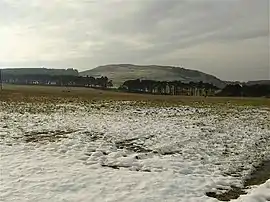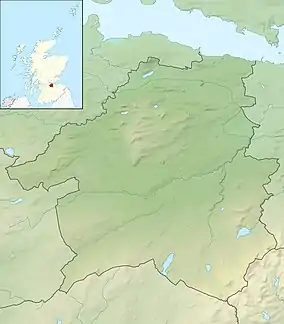Cockleroi
Cockleroi or Cockleroy[2] is a prominent hill in Scotland.[3][4] It is Linlithgow's local hill. On its top there are some remains of an Iron Age's hill fort.[5]
| Cockleroi | |
|---|---|
 Pathway to Cockleroi | |
| Highest point | |
| Elevation | 278 m (912 ft) [1] |
| Prominence | 59[2] |
| Coordinates | 55.95163°N 3.61988°W |
| Geography | |
 Cockleroi | |
Etymology
There are multiple explanations for the name Cockleroi. The most phonetically plausible is derivation from Gaelic *cochull-ruadh meaning "red cap, hood or mantle".[6] Less convincing Gaelic derivations are *cachaileth ruadh, "red gate",[6] *cuchailte ruadh, "red residence, seat".[6] The name may be Brittonic and derived from *cloc-erjo- (from *clog, "rock, crag, steep cliff", Welsh clegyr),[6] suffixed with rūδ, "red" (Welsh rhudd),[6] but this requires double metathesis and unexplained reversion of -e- to –o-.[6]
 Rigs on Cockleroi
Rigs on Cockleroi Summit of Cockleroy
Summit of Cockleroy
References
- Coppens, Philip (2007). Land of the Gods: How a Scottish Landscape was Sanctified to Become Arthur's Camelot. BookBaby. ISBN 9781623092344. Retrieved 2018-11-06.
- "Cockleroy". Retrieved 2018-11-06.
- Ordnance Survey: Landranger map sheet 65 Falkirk & Linlithgow (Dunfermline) (Map). Ordnance Survey. 2012. ISBN 9780319229705.
- "Ordnance Survey: 1:50,000 Scale Gazetteer" (csv (download)). www.ordnancesurvey.co.uk. Ordnance Survey. 1 January 2016. Retrieved 18 February 2016.
- Mountain, Harry (1998). The Celtic Encyclopedia. 5. Universal-Publishers. p. 1202. ISBN 9781581128949. Retrieved November 10, 2018.
- James, Alan. "A Guide to the Place-Name Evidence" (PDF). SPNS - The Brittonic Language in the Old North. Archived from the original (PDF) on 13 August 2017. Retrieved 25 November 2018.
This article is issued from Wikipedia. The text is licensed under Creative Commons - Attribution - Sharealike. Additional terms may apply for the media files.